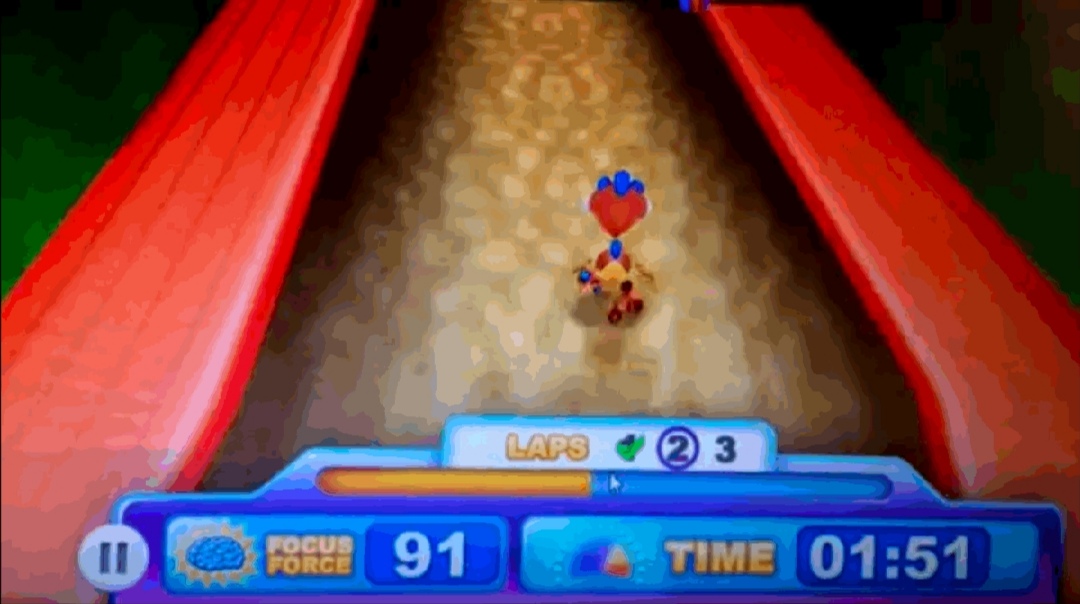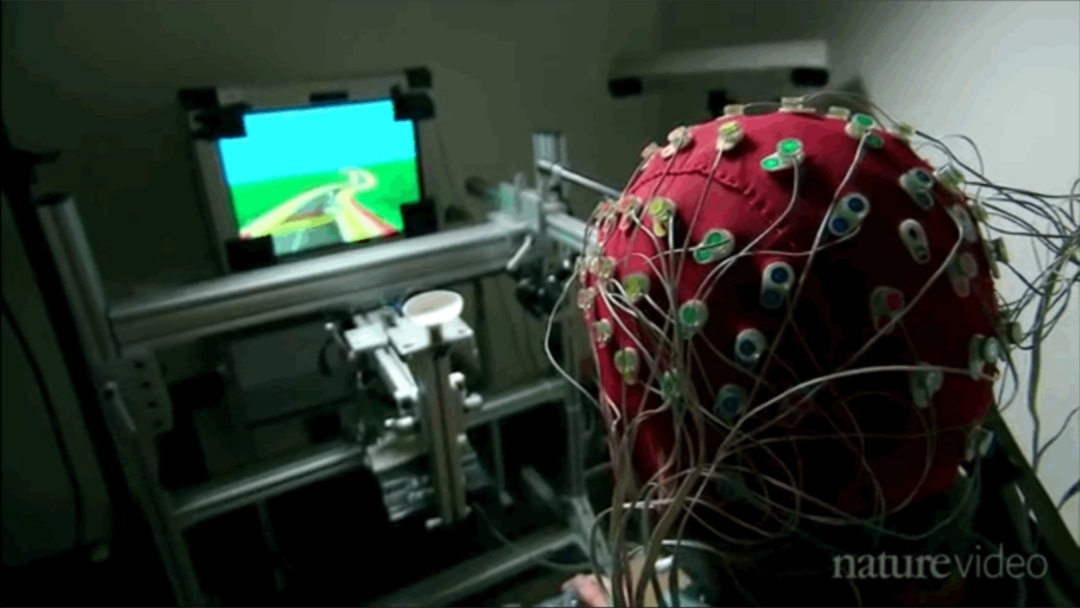The day is fine and the sun is high and the road goes on forever. A single lane wraps around the Technicolor landscape, a deep blue ocean sparkling in the distance. The music is a jaunty calypso ditty, and, like most video-game soundtracks, I fear I will never get it out of my head. I’m staring into the screen of a standard issue laptop computer, but my hands are in my lap, touching neither keyboard nor mouse. Stretched around my head is a black elastic headband equipped with sensors that monitor electrical activity in the front of my brain and wirelessly transmit it via Bluetooth to the laptop. I look a bit like a laboratory subject in a psychology experiment, which I suppose I am. On the screen, in the middle of the road, stands a 3-D animated chicken. In cowboy boots.
I’m looking at her from above and slightly behind, as in a first-person shooter game or FPS. Let’s call it an FCS — first-chicken shooter. Once I get over the nearly irresistible temptation to make stupid jokes about chickens crossing roads — it turns out that everyone who encounters this bird experiences the same baseline urge — I get to work. I breathe deeply, banish all distractions, and focus on the chicken. I’m not even sure how and I’m not given detailed instructions. I just tell myself: chicken, run!
Suddenly, as if by magic, she starts to move. Now I am really focused, and soon she shifts gears from a walk to a trot, her feet kicking up little clouds of dust as she clucks along. I am making the chicken run with my mind! The day is fine and the chicken is a badass and we are running down the road together, our minds locked into one another’s like some sort of Farmer Brown’s Patented Olde-Time Vulcan Mind Meld. When the road turns left, she turns left, then straightens out on a section overlooking the ocean. Look at the way the sun hits the . . . wait, why is she stopping? Is it because I was looking at the ocean? I drag my gaze back to the chicken. She begins to move again.
Just to be sure, I try a little experiment: With the chicken once again running at a nice clip, I begin to think about that creamy latte I enjoyed on the way over here just a few minutes ago, at that French café down on Second Avenue. It’s a chain, I know, but the barista, a heavyset, heavily pierced young man, did a fine job on my latte. The foam was sweet and light, and he even swirled it into a little . . . OK, my chicken has stopped. In the three seconds that my mind drifted, she lost her will to run. The calypso music keeps playing, but she is standing patiently in the road, awaiting instructions.

It turns out that my latte daydream, as brief as it was, simulated the basic symptoms of attention-deficit/hyperactivity disorder or ADHD, a neurobehavioral condition that affects at least 6 million children. I’m sitting in a little room off the library of the Churchill School, a private day school in the Kips Bay section of Manhattan’s East Side. Churchill specializes in educating children with attention problems, and as one of their therapies they’re piloting this game, created by a Massachusetts outfit called Atentiv. Developed in collaboration with Duke University neuroscientist Ranga Krishnan, it’s part of a burgeoning field called therapeutic neurogaming, which turns the mechanics of digital games into actual therapy that its proponents say can calm kids down, focus them, and help them overcome debilitating conditions like ADHD, anxiety disorder, depression, and even, in the near future, certain types of autism, so they can concentrate on schoolwork. It’s built on two basic ideas: First, that the brain is “plastic” for far longer than scientists once believed, so healing can be achieved in schoolchildren of all ages without drugs, through basic neurofeedback therapy. Second, that therapy doesn’t just happen — it requires work and patience and a regular dose of practice. Since games encourage people to spend time playing them, the theory goes, players will return to them regularly. Patients are more likely to make progress with a therapeutic game than with regular therapy that may be tiresome or dull. In medical terms, people who are playing an absorbing game will take all of their medicine.
The stakes are high. In 2011, the federal Centers for Disease Control and Prevention estimated that health-care providers had returned ADHD diagnoses for more than one in ten school-aged children and one in five high-school boys. The percentage of children taking medication for ADHD, as reported by their parents, grows about 7 percent each year. In 2011, an estimated 3.5 million children were taking ADHD medicine, 1 million more than in 2003. The U.S. Food and Drug Administration has warned that side effects for Ritalin, one of the most popular ADHD drugs, can include high blood pressure, stroke, heart attacks, and, for users with heart problems, sudden death. The FDA also says Ritalin can stunt children’s growth and give them blurred vision, headaches, seizures, decreased appetite, nausea, sleeplessness, and, for young men, “painful and prolonged erections.” It can also cause psychiatric problems, including bipolar disorder.

So for the past few years, a small group of psychiatrists, researchers, educators, and game designers have run a quiet but intense footrace to become the first to earn FDA approval for a medically sound, prescription-strength video game for ADHD. That’s not a metaphor. They are seeking approval for a game that a doctor can actually prescribe.
The problem with drugs like Ritalin or Adderall, researchers say, isn’t just that they have side effects. It’s that they’re almost entirely hit or miss. They activate “your entire brain, in a very blunt way,” said Dr. Adam Gazzaley, a psychiatrist and founding director of the Neuroscience Imaging Center at the University of California–San Francisco. “We don’t really have a selective way to target their effects, and because of that we have to increase their doses to very high levels,” he said. Most drug-prescription guidelines for doctors are entirely nonpersonalized, based on population data rather than the needs of the patient sitting in front of them. And once they’ve got the medicine, he said, there’s an inherent delay between the time a patient takes it and the time that a doctor sees the effects, usually during the next office visit. “We have this very open-loop system, and I maintain that this is just really not good enough,” Gazzaley said. A few years ago, he began searching for a new way to treat his patients, for a tighter feedback loop that was “targeted, personalized, multimodal, and closed-loop.”
Gazzaley got interested in video games after reading medical literature that showed first-person shooters improved the cognitive abilities of players, both expert and naïve. He knew that as we get older, we have a harder time switching between different tasks, partly because of a phenomenon he calls “stickiness of perception.” Like doors hanging on rusty hinges, as we age our brain develops difficulty swinging from task to task, not only because it’s hard to swing over to the new task, but because it’s difficult to disengage from the old one. Gazzaley began wondering if he could develop a game to enhance this switching in older adults. At the time, a few of his friends were working for the game developer LucasArts, so he asked if they’d be interested in helping him out. They said they’d be delighted. “Their perspective was that they’d been teaching teenagers how to kill aliens for fifteen years now — most of their professional life — and they were looking forward to the opportunity to work on games that might have a different kind of impact.”
Gazzaley’s team developed NeuroRacer, an immersive 3-D cognitive trainer that, in many ways, resembles the Atentiv chicken game, though it predates it. NeuroRacer requires players to steer an animated racecar down a winding road while reacting to different colored shapes along the way. If players see a green sign, they press a button. If they see a red or blue sign, they try to ignore it. As they improve their multitasking skills, the game gets harder, but if players can’t handle the simultaneous tasks, the game gets easier. That is its “special sauce,” Gazzaley said. Unlike the real world, where as you get better at a task it gets easier, in NeuroRacer, reality is reversed in the name of science.

If the game were a dose of medicine, not only would patients be taking all of it — the medicine would be adjusting automatically, moment to moment, to their needs: When you make a decision, it impacts the game. The game shifts and feeds you a different challenge and you react to that. The feedback loop is closed. “The challenge scales to your skill level, so it holds you right in that sweet spot, which our game designers like to think of as a ‘flow state,’” he said. Brain scientists might call it “maximizing brain plasticity” or simply scaffolding learning more efficiently. “You’re just pushing the system hard enough that it can change, but not pushing it too hard that people give up,” Gazzaley said. Actually, a well-designed game could go one step further, using that feedback to map your cognitive strengths and weaknesses and feed you challenges that put just the right amount of pressure on them.
In a groundbreaking 2013 paper in the journal Nature, Gazzaley and his colleagues published their NeuroRacer results. They found that subjects in their early twenties were the best multitaskers, but that after the training, sixty- to seventy-year-olds performed just as well as twentysomethings, even a month after the sessions. Seniors’ enhanced multitasking abilities remained as long as six months later. Their working memory also improved, an unexpected and promising outcome that showed a positive effect of brain training at a time when many in the scientific community were souring on the idea. It’s as if, Gazzaley said, you went to the gym for a month and were still as strong half a year later.
With the success, Gazzaley began working on a game about mindfulness, funded by the National Institutes of Health (NIH), and, through a company he co-founded, Akili Interactive Labs, another game for elementary-school-aged children that could treat ADHD, depression, and other disorders. One of the initial investors in the trials was the Irish drug company Shire Pharmaceuticals, makers of Adderall. “What we hope is literally in five years that we can drop those doses down, in some cases potentially remove them, and then use a game to selectively activate a circuit in your brain,” Gazzaley said. He also began working with researchers at the University of California–San Diego to develop a combination MRI/EEG brain-imaging device that connects to a game and feeds real-time images of players’ brains into the game engine. Imagine, he said, watching your brain cells fire onscreen in a 3-D animation and having the ability to change the pattern as you watch. The device could someday allow researchers and game developers to tweak simulations so that they actually heal players’ cognitive deficits — even injuries. “Video games are a really powerful way of changing the brain because what they do is activate circuits,” he said. “We don’t have drugs that do that — we don’t have that level of selectivity and that’s how games act. Because you interact with the environment in a targeted way, your brain acts selectively.”
For all its science-fiction surreality, the development was inevitable. Though video games began as arcade amusements built almost entirely around quick reflexes and hand-eye coordination, forty years of rapidly improving computer technology and two generations of imaginative developers have pushed games into terrain that often borders on the therapeutic. In 2014, the Netherlands-based Playnice Institute developed MindLight, an EEG-powered game aimed at children as young as eight years old to help them with anxiety disorder. Puzzles and relaxation exercises teach kids how to face “fear events” and conquer them. In San Francisco, the startup Puzzlebox in 2012 began selling an EEG-controlled toy helicopter that only flies when users are calm and focused — it followed years of the company’s founder working with elementary and middle-school students on focusing techniques.

Another San Francisco startup, Emotiv, has developed a $399 EEG headband, designed for research, with fourteen brain-sensor points. It already allows users to see an onscreen 3-D visualization of their brain areas firing. Another utility guides users through the process of coaxing a photorealistic digital flower into blossoming. At a gaming conference in 2014, I sat at Emotiv’s booth and watched as an employee squirted saline solution onto each of the contact points, then handed it to a co-worker who, as he lowered it onto my head, said, “This is going to feel a little cold.” He was right, it felt a little cold. On the screen was a single white rose, but the bud was shut tight, almost unrecognizable as a flower. As I focused on the shape, silently willing it awake, then audibly saying, “Open, open . . .” its papery petals began to peel apart, slowly and tentatively at first, then a little bit more confidently. In a few seconds it sat before me, fully open. Perhaps my brain was secretly gloating, because a moment later it quickly sealed itself shut, as if sensing danger. I told myself to relax a little more and stop gloating, and it opened again. Soon I was watching it open and close in tandem with my breathing. The rose and I were breathing together.
Game designer Robin Hunicke, who has worked on several genre-bending titles, said technologies like these point to a new direction for games. “We are at a place right now where this medium has the opportunity to expand in drastic and amazing ways,” she said. “And if you are a designer, I would hope that you’re curious enough to really push on that boundary and not just accept the status quo, not just work on a game because you know it will make money, but to really push yourself in your craft to design something new.” Improvements in technology have actually upped the ante for developers, she said, giving them greater responsibility for players’ well-being. “You can’t just make games about shooting people in the face because now you can see how people feel.”


You must be logged in to post a comment.